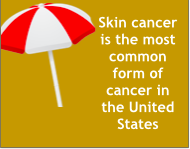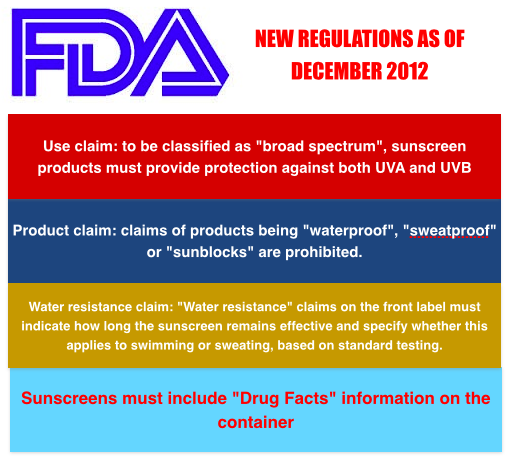Sunscreen 101: UVA/UVB Breakdown
HAVE YOU HUGGED YOUR SUNSCREEN LATELY?

Remember when we were young, foolish, and in love with the sun? (You know we all used baby oil on our skin and lemon juice in our hair!) Well my friend, those days are over.
We’ve all heard (and perhaps been confounded by) the buzz terms ‘broad spectrum’ and ‘UVA/UVB’ -sunblock can be waterproof, sweat proof, water resistant, pheromone-laden… the list goes on.
We are here to help – let’s break it all down.
WHAT’S WITH THIS UVA/UVB BUSINESS?
The sun emits two types of rays that are dangerous for your skin – UVA and UVB.
Both rays penetrate the atmosphere and play an important role in conditions such as premature skin aging, eye damage (including cataracts), and skin cancers. They also suppress the immune system, reducing your ability to fight off these and other maladies. [Source: www.skincancer.org]
But, each UV ray affects the skin differently at different levels.
UVA is the ray that causes cumulative damage over time. It penetrates the outer layers of the skin and actually injures the skin’s DNA. It is the primary tanning ray and has been proven to contribute to and may even initiate the development of skin cancers (melanoma and squamous cell carcinoma). UVA rays are especially dangerous because they are equally as intense throughout the daylight hours. This is also the culprit for photo aging — wrinkles and (gasp) sagging skin!
UVB rays are the reason your skin turns red and burns — they mostly affect the superficial layers of your skin. Although it only contributes to tanning and photo aging, it is still a major factor in development of skin cancers. Unlike its UVA counterparts, it varies by season, location and time of day. The time period between 10 AM and 4 PM hold the most intense rays.
AND THAT MEANS WHAT FOR SUNSCREENS? 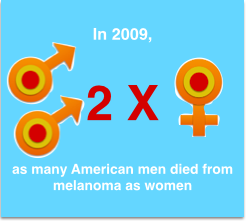
There are literally hundreds of sunscreens to choose from. How do you pick which one is right for you and your family? How often do you use it? How does it fit in to your daily skin regimen?
The most important thing to remember when purchasing your sunscreen is to choose sunscreen that is broad spectrum.
Remember those pesky UVA and UVB rays we just talked about? If your sunscreen doesn’t say “Broad Spectrum” or list that it offers UVA and UVB protection, put it down and step away. There are specific guidelines set by the FDA to be able to make this claim on the packaging. If you don’t see it, you are most likely still being exposed to the dangerous UVA rays — and we learned above that those are the rays that cause the most damage over time.
Your sunscreen should include one of the following ingredients:
- ecamsule
- avobenzone
- titanium dioxide
- sulisobenzone
- zinc oxide
WOW. That list above is full of words I can’t pronounce. Translation on the chemicals in sunscreen please?!
Yes, there are chemicals that are okay and chemicals that are not in sunscreen.
The Environmental Working Group (EWG) publishes a lot of great information – especially on sunscreens and how to choose them. To make the their safe list, sunscreens must be free of oxybenzone, retinyl palmitate (a type of vitamin A), not have SPF above 50 and protect against UVA and UVB sunrays.
Although the FDA says that the chemicals are safe, studies have linked it to hormone disruption and potentially to cell damage that may lead to skin cancer.
Click here to read the full article on CNN.com.
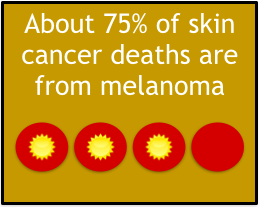
Here are other factors that may influence your decision. Here are a few common types of sunscreens and their benefits:
Water and Sweat-Resistant – The FDA defines water resistant sunscreen as meaning that the SPF level stays effective after 40 minutes in the water. Very water resistant means it holds after 80 minutes of swimming. They are not in any way waterproof so you will need to reapply after swimming or heavy exercise.
Sensitive Skin – People who have sensitive skin or skin conditions like rosacea may also benefit from using sunscreens designed for children. Look for titanium dioxide or zinc oxide instead of chemicals like para-aminobenzoic acid (PABA), dioxybenzone, oxybenzone, or sulisobenzone. If you have skin irritation or allergies, avoid sunscreens with alcohol, fragrances, or preservatives.
Spray Sunscreen – The sprays are great for those hard to reach areas and make for easy reapplication. Sprays are also good options for areas with a lot of hair – like a man’s chest or a scalp. Just make sure you use enough, don’t inhale the product, and reapply more often than you would a cream.
Moisturizer with Sunscreen – We all know that wearing sunscreen is a must for our daily routine. There are many great products on the market that add a sunscreen factor to your moisturizer. Although they are a great first step to your day, they are not a one-stop-shop. Make sure they contain broad spectrum, have the correct SPF number for your lifestyle (office, outside, both…), and remember to reapply during the day. There are also a bunch of products that include a tinted moisturizer as well to give you a nice, even skin tone with your moisturizer/sunscreen combo.
Use sunscreen year-round, but don’t let any product lull you into a false sense of security about sun exposure. A combination of shade, clothing, sunscreen and common sense is your best bet. [Source: Mayo Clinic]
Recommendations from Not Just Faces:
Neova DNA damage Control Silc Sheer – An advanced physical sunscreen for the face with the cosmetic benefit of skin-perfecting tint that evens out skin tone
Neova DNA Damage Control – An elegant, lightweight moisturizing formula designed especially for daily protection of the face, neck, décolletage and back of the hands.
MelaShade E from Young – With a silky rub-in and matte finish, MelaShade leaves no shine, no stickiness and no odor on the skin. The inert, fragrance-free, preservative-free vehicle is ideal for patients with sensitive skin, or post-treatments that leave skin dry or irritated. Contains only Titanium dioxide and Zinc oxide for gentle, broad-spectrum UVA and UVB protection. Elegant, anhydrous silicone elastomer vehicle leaves a non-shiny, non-sticky, mattifying film on the skin surface which dries clear. Contains microencapsulated Melanin, Vitamins C, E and Ferulic acid ester for enhanced anti-oxidant protection.
Revision Intellishade, SPF 45 – An anti-aging moisturizer that meets all of your needs – broad-spectrum sunscreen, an anti-aging moisturizer, and tinted makeup base.
LIP 20 ALL IN ONE – This anti-aging breakthrough is the first of its kind to moisturize, repair, enhance natural fullness and protect with SPF 20 – all in one application.
Lira Lip Factor 15 – This nourishing lip balm contains ingredients like avocado and jojoba oils and hyaluronic acid with the protection of SPF 15.
OK, I GET IT…HOW CAN I MAKE SURE I APPLY SUNSCREEN CORRECTLY?
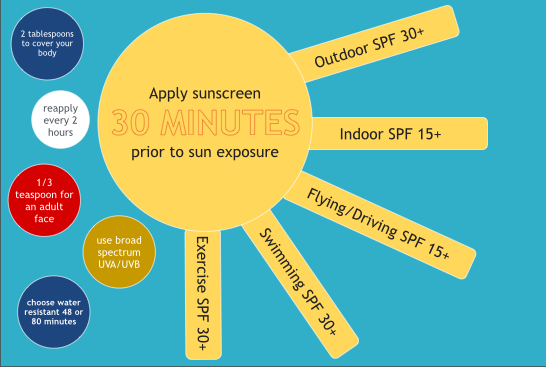
Quick Rules for Sunscreen Application
Apply sunscreen about 30 minutes prior to direct sun exposure
Use at least 1-2 teaspoons of sunscreen on your face (1 teaspoon for children)
Apply 2 ounces of sunscreen to your entire body
Reapply every two hours – or immediately after swimming, exercising or wiping down with your towel
Choose a water-resistant sunscreen for swimming and exercising
Don’t forget the forgotten spots – the tips of your ears, backs of hands, feet, back of your legs and lips.
HOW ABOUT SOME ACCESSORIES TO GO WITH YOUR SUNSCREEN?
Now for the fun part. Accessories. We all have them. We all love them. We always look for an excuse to buy more. Here is a list of your sun protecting must-haves:
Wide brimmed hats aren’t just for the Hamptons! The skin on your neck and decollate are just as important (and as visible in every day fashion) as your face.
Sunglasses, the bigger the better! Channel your inner Jackie O, protect your eyes, and keep those pesky little crows feet where they belong — on a bird! Polarized lenses are also a great idea. Higher end lenses are made from a polycarbonate material that not only has UV protection, but cuts glare and allows you to see truer colors.
With almost as many cover ups options as swimming suits these days, there is something for everyone. Maxi dresses, long tanks, tunics, sarongs, beach pants…I could keep going.
Rash guards, swim shirts – whatever you call them, they are always a good idea when you are spending hours at the beach. There are many options – colors, short sleeves, long sleeves, designs – something for everyone.
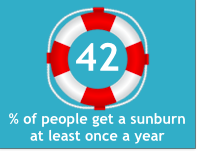
Need more ammo to share with your friends?
Here are some articles to check out:
FDA Sunscreen Regulations Update
Spot Skin Cancer

